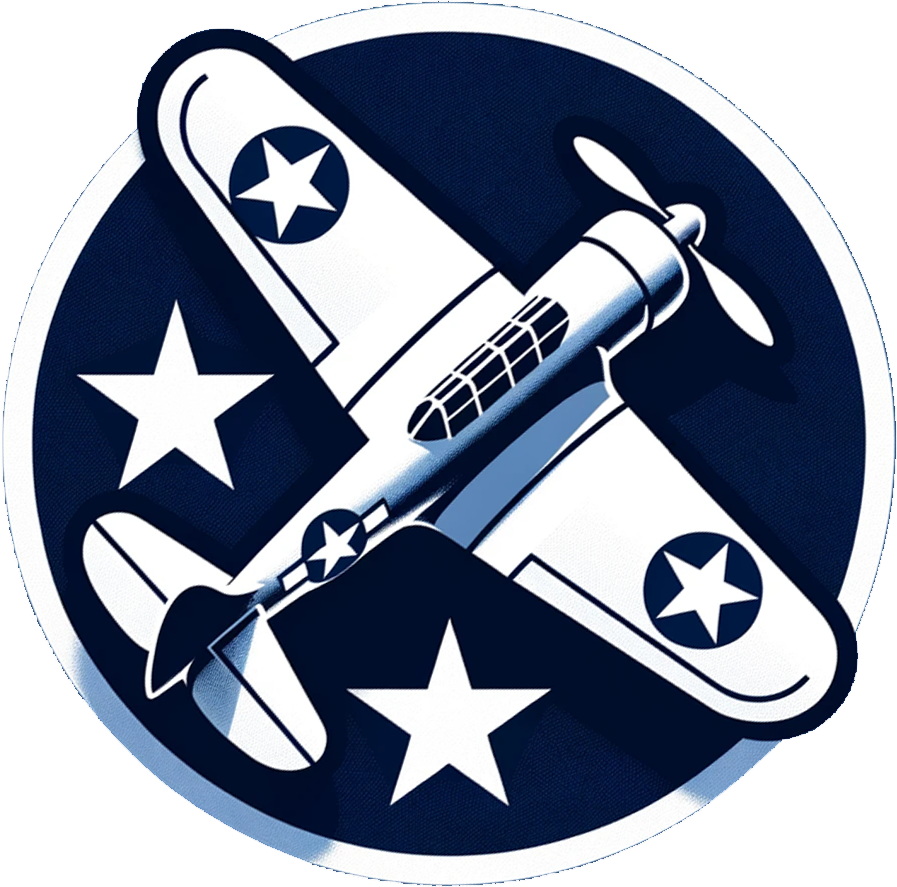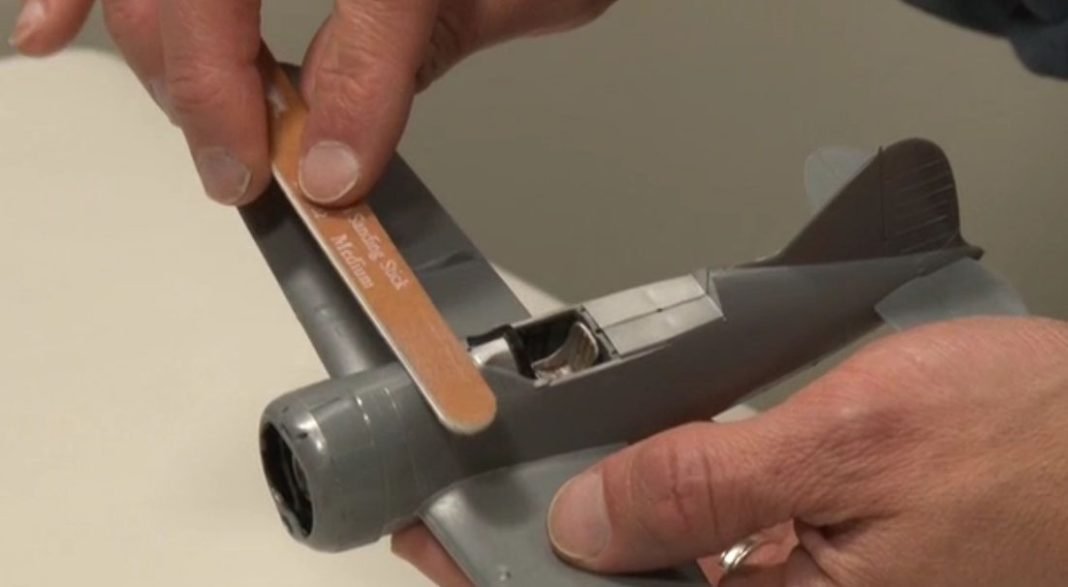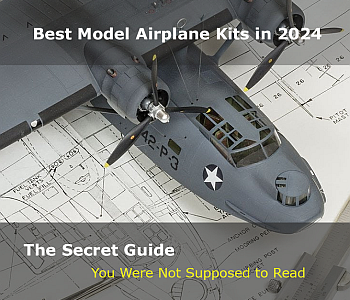Filling and Sanding Plastic Model Aircraft
Filling and sanding
Contents
Even the best model and the most careful dry-fitting will often result in a “seam” or join line between the assembled parts. Removing the seams and join lines is essential for the model to look like a fine replica of a real-life object, and not just a bunch of plastic parts sloppily glued together.
Some assemblies almost always tend to result in unnatural gaps or cracks between the parts. Usual problem areas are for instance the wing roots (where the wings meet the fuselage of the aircraft) and the mating line between the left and the right part of the fuselage. If left unattended, these areas will give your model a rather “toy-like” appearance.
Getting rid of these areas is really not a hard or complicated work, but it will take time, patience and a few tools: a sharp model knife (X-Acto knife), some wet-and-dry sandpaper of various grades (600 – 1500 grade), model putty, primer and a paintbrush or airbrush.
Sometimes – on more expensive Japanese models – only some scraping with the back of the blade is needed to make the worst mating lines disappear. But on other models, several filling and sanding sessions must often be done.
Putty and filler
You should always try to eliminate gaps and seams as much as you possibly can. To fill the gaps, most often you will need some filling material or model putty.
Different modellers swear by different brands of putty, but some of the most common brands are Squadron Green and Testors Contour Putty. They are both readily available in hobby stores and can be used straight out of the tube.
Other ones (such as Milliput) are so-called two-component epoxy putties where two fluids must be mixed to correct proportions before you can use them.
Which one you like the most is really up to your personal preferences and their intended usage. For general gap filling, I recommend single component putties, as they are quite easy to use.
Model putty doesn’t just adhere to the plastic like play-doh, but it contains chemicals (most often toluene) that will slightly melt the plastic surface so the putty can become almost a part of the plastic itself. Very effective indeed, but you should be aware of the fact that toluene is a highly toxic chemical. It is needless to say that you should have plenty of ventilation around your working space when working with hazardous chemicals.
To apply the putty, just put a dab on a knife, and wipe it along the seam to get an even coverage without bubbles or lumps. Don’t apply more putty than what’s absolutely necessary, or you will just have to wait longer for it to dry and have more work sanding off the excess.
This method works best on larger areas that need to be filled. For minor filling work or for filling in areas that are hard to reach, there is a better method. Mix a little acetone (nail polish remover) and putty in a small container, such as a Coke bottle cap. The mix should be quite thin because it will thicken incredibly fast as the acetone evaporates.
Use a cheap brush to “paint” the mix on where needed. You will find that the mix runs very easily into all the cracks and nooks you want to fill.
Sanding
When the gaps have been filled and the putty is dry, you are in for a boring but nevertheless necessary task; you must now sand the filled joins. Start with 800 grit wet-and-dry sandpaper and gradually work your way down to 1200 or even 1500 grit sandpaper.
Be very careful not to sand off too much plastic, or you may ruin the subtle shapes of your model. Take frequent breaks and check the parts under a strong light source so you can spot the rough areas still in need of some sanding. Keep the sandpaper wet all the time, or you may end up with ugly and hard-to-remove scratches on the plastic surfaces.
As you sand off the excess putty, you will notice that the putty has almost become a part of the plastic and conceals the gap very effectively. Since all putty has a slight tendency to shrink and crack, you may find small cracks and tiny bubbles in the putty. Just put on another thin layer of putty to fill these tiny imperfections and sand it flush one more time.
When you feel happy about the filled areas, wash the model under running water to remove all the sanding residue. I sometimes even use a Scotch Brite pad to carefully rub off the most stubborn sanding particles.
Even if the putty probably has a different colour than the plastic parts, it will not be visible once the model has been painted. But it may make it quite hard to spot remaining cracks and imperfections.
When the parts are fully dry, spray a coat of primer over the area you’re working on. You can either choose to buy special primers (such as Halford Gray or Mr Surfacer), but for the casual modeller, a white or light grey acrylic or enamel paint will work just as fine. The primming is very important for several reasons: it will seal the putty and help you discovering rough areas that still require some attention and it is also a far better base for the final paintwork than the bare plastic.
Before priming, don’t forget to cover the cockpit opening with some masking tape and plastic foil, or your finely detailed cockpit might catch some primer overspray. It is also very important that the model is absolutely clean from any sanding residue. If any dust remains on the parts, you will get a lumpy and ugly surface as result. If you wash the model under running water to get rid of the dust, make sure that no water is left inside the wings and the fuselage when you paint to model because any water trickling out from some hidden orifice of the aircraft while painting will create a real mess!
When the primer is dry, use an even finer grade sandpaper (1200 or even 1500 grade) to even out minor imperfections and remaining rough areas. You may even have to use some more filler. Keep on filling and sanding until no evidence of the join line remains even in a strong light falling from the side.
Some areas can be quite hard to reach with the sandpaper, and you may have to improvise a little. You can, for instance, wrap a strip of sandpaper around one end of a popsicle stick or an ice-cream stick and use this tool to get into corners. Other areas are even harder, such as the dreaded jet intakes on the A-7 Corsair and the S-3 Viking aircraft. You will have to utilize all your skills to come up with a good result. If you have any tips, you’re more than welcome to share them with me!
Most model builders – like myself – find this part of a model building project the most boring one. A lot of waiting is involved, which slows down your building progress most considerably.
Nevertheless, I still advise you to take your time. Every minute you spend here will pay dividends later on when it’s time to paint the model!
If you think it’s too much waiting, work on more than one model at a time. I know that I keep repeating this advice during the course of this web site, but it’s because it is a far better solution than rushing on impatiently and risking to ruin your masterpiece.
Unfortunately, some surface detail is inevitably lost during the sanding process, like rivets or panel lines. If you wish, you can try to restore the lost panel lines by carefully recarving them with a scribing tool or knife, but I must admit that I have never really been very successful with this technique. An easy way to protect delicate details and panel lines around the area to be sanded is by simply covering them up with masking tape.
Other filling materials
For major filling and reshaping work, you can use epoxy putty instead (such as Milliput). This putty is somewhat more difficult to work with because it consists of two different chemicals that must be mixed before use. The benefit is that it is stronger and smoother than single-component putty, and does not crack quite as easily when applied in heavy layers.
I feel that a fair word of warning should be issued though – all putty contains a plastic solvent to help it bond to the plastic. As this solvent evaporates in air, the putty hardens and almost becomes a part of the plastic. But if you completely fill a large area with putty without enough exposition to air, the solvent will melt and distort the plastic parts!
I was once building a 1/32 Tornado fighter aircraft, and I had to put some weight into the nose of the aircraft to make it sit correctly on its landing gears. Squeezing a large amount of putty, I filled the entire nose cone with putty and then I pushed in a few nuts and bolts. Guess what: the next morning the entire nose cone had turned into a puddle of plastic with a few protruding nuts and bolts… I didn’t kill myself laughing at that time!
Sometimes model putty is not enough to fill some gaps, and you may have to improvise, using other methods and materials. Other gap-filling materials I have used with some success are scrap styrene plastic and even Tip-Ex correcting fluid.
Superglue can also be used to fill gaps very efficiently. It also dries very fast without shrinking or leaving bubbles and will bond very well to the plastic. The only problem with superglue is that it is much harder than the surrounding plastic, so care must be taken while standing so that you won’t erode the plastic around the filling.
Styrene plastic cards are very useful for scratch-building or for filling large gaps, which unfortunately can occur on many older and cheaper models. You can buy styrene cards in various thickness and sizes in most model shops. Since these cards are made of the same material as injection models, you can easily modify them to the desired shapes using the same tools and techniques as the regular model parts. You even use the same kind of cement to glue them together and onto your model. It’s also very cheap material, so don’t shy away from purchasing some.
Clear parts
Clear parts, such as canopies, are sometimes quite badly scratched and optically distorted. This is even more usual for older and cheaper kits. In modern and more exclusive model kits the transparent parts are often separately bagged inside the box. Clear parts can also be sanded, even if you probably don’t want to do that on your first model. Apart from removing scratches and minor damages, quite often I like to sand off out-of-scale frames too. I avoid sanding the inside of curved canopies though – because of the higher curvature, it can be nearly impossible to polish back the clarity later! Usually, I start sanding with 1200 grade sandpaper and work my way down to 2000 grade sandpaper.
At this point, I have a very smooth canopy almost free from scratches, but which of course is totally fogged up and cloudy – scary the first time! You would think that the canopy is ruined, but it’s not! I now just use kitchen tissue and some polishing compound, such as microgranulate toothpaste or metal polish, and start rubbing the canopy. After about ten minutes, the clarity of the canopy is restored to a much higher degree than it ever was.
In the end, I carefully dip the whole part in Future Floor Wax (or Johnsons Floor Wax for plastic floors, as it is called here in Sweden) and let it dry overnight. The result is short of a miracle: the canopy usually ends up so shiny and transparent that it’s hard to believe that it is the same part! I recommend you to try it one day!
Adding the details
When the major parts of the model are assembled, the join lines are filled, sanded and primed, it’s time to add the fins, stabilizers, pylons and the rest of the main parts to the model. This is quite a relaxing and pleasant step of a model building project. Work slowly and carefully, and enjoy how all those plastic parts slowly turn into a single entity.
Some parts need to be painted before they are glued in place and you better read the instructions for your model so you don’t miss adding a part that cannot be fitted later on. Some minor assemblies may also require you to perform some filling and sanding.
With all the main details in place, you should prime the entire model in a light grey or white colour. I like to prepare for the final paintwork already at this stage, so if I am going to simulate faded or dirty paint on the final camouflage, I spray fuzzy, dark grey zones along the panel lines. This technique is called pre-shading. When the final camouflage is sprayed on, the underlying darker and lighter areas will affect the hue of the camouflage and give the impression of the paint being sun-bleached. Remember to keep the dark areas approximately two or three nuances darker than the final camouflage, or the effect may be too strong and unrealistic.
When the primer is fully dry, it’s time to load the airbrush with the final paint and start painting. Painting is a very important part of any model building, so we will spend the next two chapters describing it in more detail!



